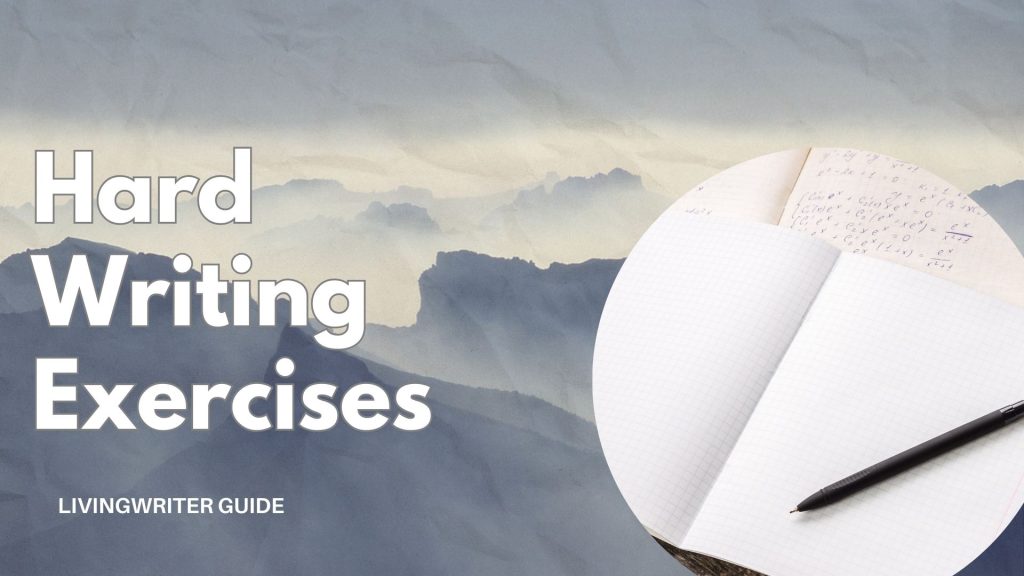7 Hard Writing Exercises For Fiction Authors

Writing exercises for fiction are focused activities designed to hone specific writing skills, such as character development, plot construction, world-building, or descriptive language. Whatever you’re doing, they’re ultimately meant to improve your overall storytelling ability.
That said, writing exercises, much like everything else, are not all created equal. Some are great, some are so-so, and some are downright bad. Today, I’ll be giving you seven writing exercises that will actually help you improve.
So, we won’t be doing anything goofy, like writing without characters or trying to write a story without the letter “e.” If you like those types of more abstract creative challenges, by all means, do them. But today, I want to give practical stuff that can actually level you up. The only catch is that they’re really hard. You’ve been warned; now, let’s get started!
Table of Contents
Hardest Writing Exercises For Fiction Authors
The Suspense Exercise
Building suspense might be one of the most crucial aspects of a good book. Even if you do a lot right (good characters, good writing, devotion), it won’t mean much without some tension and release – People have to want to know what happens next, and this is where good suspense comes in.

Unfortunetley, it’s kind of hard to do this super well without practice. It’s easy to focus on the climax and how you’re going to get the story there and not consciously think about the build-up to the big events. So, here is what you’re going to do to get better at writing suspense.
Write the paragraph before the characters find a body. You can’t mention the body in the section at all. How can you make them (the readers and characters) feel like something is about to happen and make them uneasy? Practice this one with different climax events, and you’ll notice a big difference in your lead-up sections.
Using LivingWriter’s features, like AI Manuscript Chat, can be a great way to ensure your tension is well done throughout your story. The AI is familiar with your work and can offer you very tailored feedback that outside AI can’t.
The Tree Exercise
For this one, I want you to describe a tree. However, the goal is to reveal a character’s emotions without using words in the passage. So, for example, you wouldn’t want to simply write, “The tree is happy” or something. Instead, describe the tree through the eyes of a happy character.

This exercise is great for showing that description is not neutral and that everything can tell you something about the characters in the story. As an added bonus, once you practice putting your descriptions to work adding to the story, you’ll be more likely to spot when you’re describing things that aren’t helping the story.
Single Word For Dialogue
I know I said we wouldn’t be restricting ourselves too much for these exercises. However, this one challenges you in a practical way. Write two characters exploring a new place, and they can only use a single word of dialogue. But you can use it several times.
You May Also Like: How To Write Dialogue In A Story
So, you have to use that one word to mean different things based on context. It teaches you to use a word in new ways and, more importantly, pair your dialogue to actions and context within the scene. Here is an example I did with the word “fine.”
Elias hesitated at the attic door, the smell of dust and forgotten things seeping out into the hallway. He pushed it open slowly, hinges groaning in protest, revealing a dark, cavernous space. A single, weak beam of sunlight pierced through a grimy window, illuminating dancing motes of dust. He took a tentative step inside.
“Fine?” he said.
Clara, undeterred by the gloom, followed close behind, bumping his shoulder playfully as she entered. “Fine,” she declared.
They moved deeper into the attic, navigating a maze of cobweb-draped furniture. Shadows clung to the corners, obscuring the shapes. A grandfather clock stood sentinel against one wall, its pendulum frozen. Clara, her eyes scanning the room with childlike curiosity, tripped over a loose floorboard.
“Fine!” she exclaimed, breaking the silence.
“Fine…?” Elias laughed but his voice was laced with concern as he reached out to steady her.
I used the word four times, and each time, based on the scene, it conveyed something a little different. The first one is a hesitant question. Based on the scene, you know this means, “You think this is fine? I disagree, but not in a serious way.”
Then, she repeated the word, but her tone was confident, almost challenging. Next, she trips and doubles down, using “fine” to say, “I may have tripped, but yes, I’m ok. And more importantly, this is not enough for you to be right about this being a bad idea.
Finally, he pokes fun at her fall by using the word again, this time in a sarcastic way. Overall, if you’re looking to practice your literary devices and use of subtext, this exercise works quite well.
Compressed Time
This one is fun but it’s always harder than it seems like it’s going to be. For this exercise, write a paragraph that takes place in less than a second. This was inspired, I believe, by the wonderful Flash Fiction story “Bullet to the Brain,” which mainly takes place between when a bullet is fired and when it lands.

Considering this one is challenging, I want to offer some advice: Focus on bouncing between physical and non-physical things like feelings and thoughts. If you can weave the passing of time into something physical and also look at it through a non-physical one, the juxtaposition works well.
If you can get good at this, you’ll be a wizard at writing at different speeds and new gears and playing with time to slow things down at the right time.
The Zipper Exercise
The “Zipper Exercise,” or pairing something with unrelated action and dialogue, is highly visual and translates well to screenwriting and film. However, authors can effectively use this technique to enhance their prose in several ways.
For example, internal monologue, paired with action. Or sensory details and memory. Instead of just dialogue or narration alone, you can use a character’s internal thoughts (even if they’re “random”) to spice things up.
- Example: “The rain hammered against the windows, a relentless rhythm like the opening bars of Beethoven’s Fifth. Inside, Amelia meticulously cleaned her father’s antique pistol, each click of the mechanism echoing the timpani’s ominous beat. Fate knocking at the door, she thought, her lips tightening.”
Here, the known element (Beethoven’s Fifth) is paired with the action (cleaning the gun) and internal monologue, creating a sense of foreboding and tension.
You can also use this technique with symbolic juxtaposition by using the known element to symbolize something about the character or the situation, creating a deeper layer of meaning.
- Example: “He hummed ‘Amazing Grace’ under his breath as he carefully dismantled the bomb, the delicate wires a stark contrast to the hymn’s message of redemption. Some sins can’t be forgiven, he mused, his fingers trembling slightly.”
Here, the hymn is juxtaposed with the act of dismantling a bomb, creating a contrast between the concepts of grace and destruction. It also reveals an internal conflict within the character.
For a final example, let’s looking at using this technique to link sensory details and memories. The known element can trigger a memory or sensory detail that adds another dimension to the scene.
- Example: “The smell of burnt toast filled the air, instantly transporting him back to his childhood kitchen. He was six again, watching his mother burn breakfast while reciting Psalm 23 by heart. ‘Though I walk through the valley of the shadow of death…’ he remembered, the metallic tang of blood now mixing with the smell of burnt bread as he bandaged his own wound.”
Here, the smell of burnt toast (a sensory detail) triggers a memory of his mother reciting a psalm, which then connects to his current situation (bandaging a wound). This creates a rich tapestry of sensory and emotional details.
The Secret
Merl Streep gives her characters secrets, and so should you. I covered this in the “building psychological depth” section of my article on how to write like Gillian Flynn. This is something she does very well and one of the many reasons her books are so good.
To do this, sit down and write a page of dialogue between two characters where each one has a secret that you don’t disclose in the story. In a novel, you can create tension and big reveals by gradually revealing them.
For the exercise’s sake, though, the secret itself isn’t as important as how it would influence what the character says or does. We’ve all got secrets, so I’ve started giving all my characters a secret, too; even if I don’t write it into the actual story much, I know it’s there. And maybe that makes them do some random, small thing differently than they might have otherwise.
Hemingway 6-Word Story
This one might be the hardest one on the list. You write a story with just six words. This comes from Hemmingway’s famous six-word story:
“For sale: baby shoes, never worn.”
Even with six words, the story needs depth, and that’s quite hard to do with so few words. It really helps you encapsulate Hemingway’s writing advice of “writing one true sentence” and learn to fit complex emotions and themes into incredibly tight prose.
Writing With LivingWriter
I’ve briefly mentioned how LivingWriter can be helpful with these exercises, and that’s just the beginning. LivingWriter is an author’s best friend and has been voted the best writing app of 2024 and the best writing software.
It was designed to streamline authors’ creative processes. LivingWriter’s organized structure, comprehensive note-taking and brainstorming tools, and advanced AI features make it user-friendly and easy to use.
Writers have a dedicated space for manuscripts, screenplays, and research materials, all seamlessly integrated. Writers can easily organize their work with plot points, chapters, and characters while utilizing AI-powered tools for tasks like outlining, rewriting, and even generating character art.
Collaboration features and easy exporting options further enhance the writing experience for those who share their work, co-author, or work with editors. Another big plus is the cloud-based auto-saving – On LivingWriter, every word you write is automatically saved, and you never have to worry about losing progress.